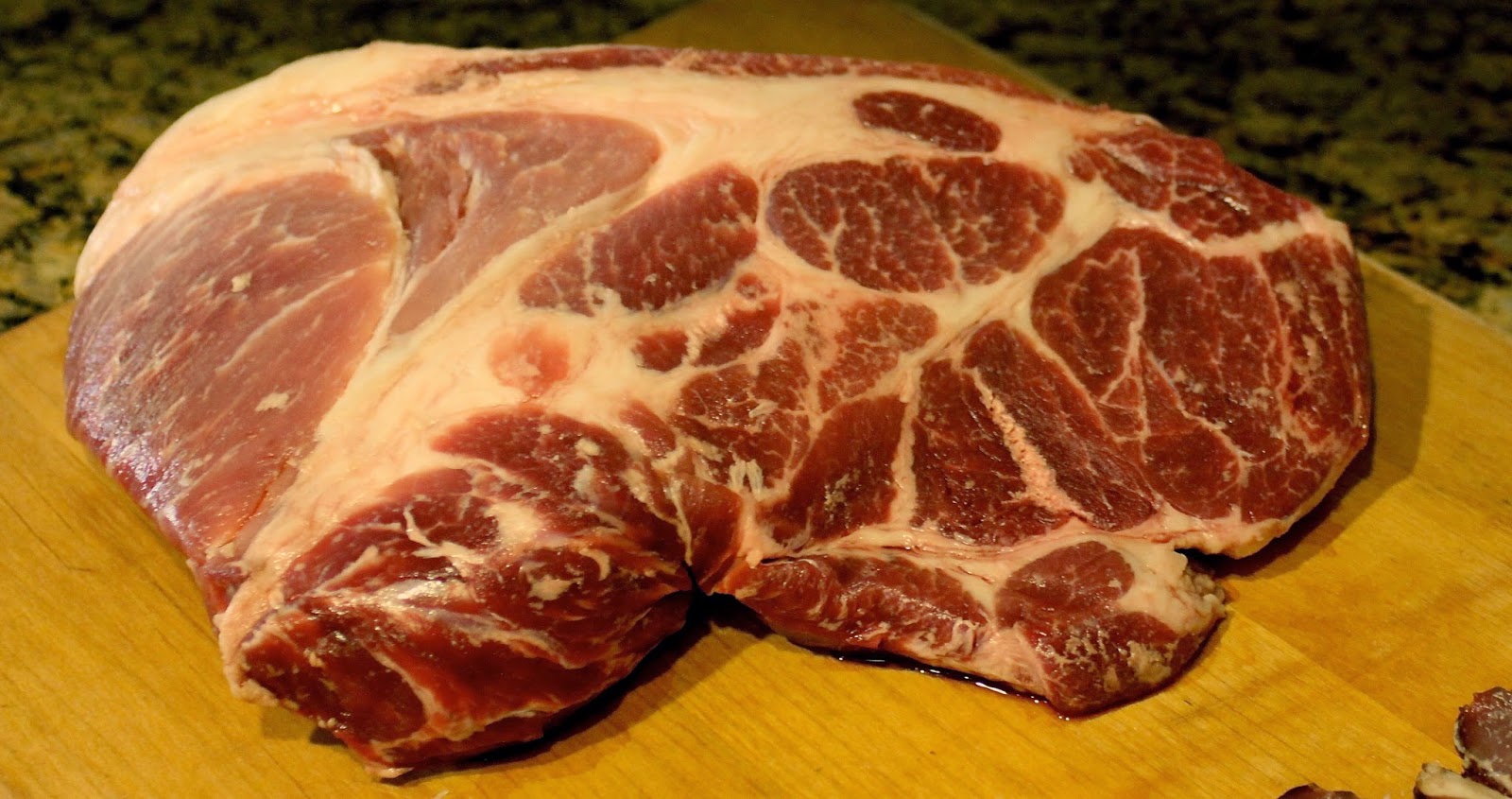Berkshire Pork Shoulder with Sauerkraut
Symbolism abounds at the start of a New Year, especially when it comes to traditional foods. Coin-shaped lentils are served to ensure wealth, while chicken and turkey are shunned as they scratch in the dirt for food, as if scraping by in poverty. Furthermore, unlike the chicken that scrapes backwards, the pig roots forward in progress. As such, the portly pig gets a much better deal on New Year’s, being a traditional celebratory food, as well as an animal that’s usually harvested in the winter. In fact, many people believe pork is the classic dish for New Year’s Day.
 |
| North Woods Ranch Pork Butt |
Whatever your reasons for cooking pork, it’s hard to go wrong with the classic New Year’s Day dinner of pork and sauerkraut. Both are traditional winter foods and pair perfectly together. It’s a rich, hearty dish that can easily feed a crowd with minimal work. It also keeps very well, so you can reheat it in the coming days while you begin working on all your 2015 resolutions.
For this dish, I used a large Berkshire pork shoulder (often called "pork butt", because it comes from the butt-end of the shoulder). I chose this cut because it had a lot of flavorful meat on it. The shoulder gets a lot of exercise as the pigs move around North Woods Ranch, which makes it an intensely flavorful cut of meat to cook. Ringing the shoulder’s outer edge is a generous layer of fat that slowly renders out during cooking. This fat enriches the sauce while keeping the dish moist and succulent. A large cut like this, with multiple muscle groups all joining together, benefits from slow and gentle cooking. Some people have a tradition of starting the pork on New Year’s Eve, so it cooks all night in the previous year and is served in the new year. If you have a crock pot, this might be a good time to get it ready.
 |
| Rendering out Berkshire Bacon |
To start this dish render out some fat from North Wood’s bacon in a large oven-safe pot, cooking it until the bacon is crisp and brown. This bacon will be used later on, so put it aside and try to keep your family from eating it all. While the bacon is frying, preheat the oven to 350 F.
 |
| Searing the Pork |
Next, sear the pork roast in the bacon fat on both sides to get a nice golden-brown crust. Once the pork is browned, add 3-4 sliced onions and a bay leaf. Turn the heat down to medium and let the onions soften. When the onions are soft and translucent, add half a bottle of dry white wine or hard cider to deglaze the bottom of the pan. I used a bottle of Riesling, as I enjoy the slightly sharper flavor of the wine. Cider works well, too, but produces a sweeter, fruitier sauce.
 |
| Adding the Riesling |
I cooked this pork shoulder for 6 hours, or until I could easily pull off a few strands of meat with a fork. At this point, it's time to add the sauerkraut. Be careful about salting this dish too much early on, as the sauerkraut and bacon will add their own salt to the sauce.
To cook the sauerkraut, give it a good rinse to get off any excess salt, then pack it in around the now-tender pork in the roasting pot. You can also add some tart cooking apples, the reserved bacon crumbles, and a bit of freshly minced garlic at this time. Now cover the pot again and return it to the oven for an hour to let the sauerkraut soften and soak up the porky juices. After adding the sauerkraut, you’ll probably have to raise the temperature to bring the liquid back to a simmer.
 |
| Ready to Serve! |
Once the sauerkraut is tender, the dish is ready to serve! Give it a quick taste to see if you need to add extra salt or pepper. You can pair this with whatever you like, from potatoes to roasted squash. I served this dish with spatzle noodles and a tart applesauce my mother had made earlier in the fall. I think some sharpness, such as the applesauce, is nice in a rich, slow-cooked dish like this. You might try horseradish or sharp mustard, depending on your tastes.
 |
| Pork, Sauerkraut, Spatzel, and Applesauce |
From North Woods Ranch to your table, Happy New Year!
Recipe at a Glance:
1 pork butt (4-5 lbs)
8 oz bacon, sliced into 1/2" strips
1/2 of a 750 ml bottle riesling
3 medium sized onions, sliced
12-16 oz pork or beef stockRecipe at a Glance:
1 pork butt (4-5 lbs)
8 oz bacon, sliced into 1/2" strips
1/2 of a 750 ml bottle riesling
3 medium sized onions, sliced
2 tart cooking apples, like Granny Smith or Sheep's Nose
3 cloves garlic
In a large, oven-safe pan, render out the fat from bacon until brown and crisp. Remove the cooked bacon and reserve. Brown the pork shoulder in the bacon drippings on both sides until brown and crusty.
Add the sliced onions and stir around the bottom of the pot, working the onions underneath the pork butt. When the onions are soft and translucent, add the wine. Scrape the bottom of the pan to deglaze. Add enough stock to cover the roast, and then bring to a simmer on the stovetop.
Cover the pan and place in a 350 F oven. After an hour, check to see that the sauce is still bubbling gently. Then turn the oven down to 325. Continue this each hour until the roast is gently cooking at 275 F. Check the pork after 5 hours to see if it's tender enough to be shredded with a dinner fork. If not, let it continue to cook for another hour.
When the pork is tender, prepare the sauerkraut, garlic, and apples. Rinse the sauerkraut under cold water and squeeze dry. Mince the garlic, then core and slice the apple. Add all of these ingredients to the pot, nestling them in and around the pork roast. Bring the oven back to 350 F and cook at a simmer for one hour.
After an hour, check the pork and sauerkraut. Add additional salt and pepper if needed. At any point, if the pork looks to be loosing too much liquid to evaporation, top up with additional stock.
Serve each guest a large helping of pork and sauerkraut, making sure to toast both the past year and the coming new year!




Comments
Post a Comment